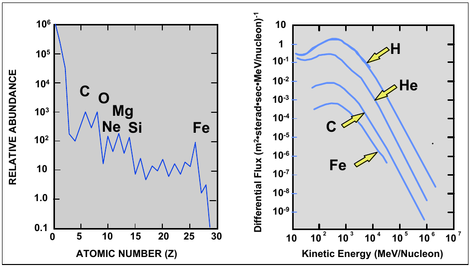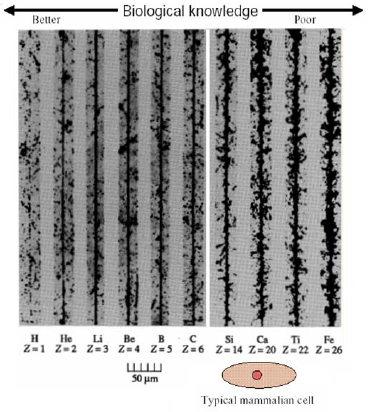Difference between revisions of "Heavy Ions"
m (Added health effects information.) |
m (→Shielding Considerations: Fixed link.) |
||
| (10 intermediate revisions by 3 users not shown) | |||
| Line 1: | Line 1: | ||
| − | Heavy ions are charged particles heavier than alpha particles.<ref>Heavy ion. (1998, Jul 20). In ''Encyclopaedia Britannica. <nowiki>https://www.britannica.com/science/heavy-ion</nowiki>''</ref> They | + | Heavy ions are charged particles heavier than alpha particles.<ref>Heavy ion. (1998, Jul 20). In ''Encyclopaedia Britannica. <nowiki>https://www.britannica.com/science/heavy-ion</nowiki>''</ref> They constitute 1% of [[cosmic radiation]].<ref>Schimmerling W. (2011, Feb 5). The Space Radiation Environment: An Introduction. <nowiki>https://three.jsc.nasa.gov/concepts/SpaceRadiationEnviron.pdf</nowiki></ref> |
| + | ==Exposures== | ||
| + | [[File:Heavy ions in GCR.png|thumb|<ref>Schimmerling W. (2011, Feb 5). The Space Radiation Environment: An Introduction. <nowiki>https://three.jsc.nasa.gov/concepts/SpaceRadiationEnviron.pdf</nowiki></ref>Abundances and energies of heavy ions in cosmic radiation.|470x470px|alt=]]The left-hand graph shows which elements make up the heavy ions in cosmic radiation. The right-hand graph shows the distribution of energy levels for 4 ions. For example, carbon is one of the more abundant ions in cosmic radiation, and the most likely kinetic energy level for a carbon ion falls between 100 and 1000 MeV. | ||
| + | <br> | ||
| + | <br> | ||
| + | <br> | ||
| + | <br> | ||
| + | <br> | ||
| + | <br> | ||
| + | <br> | ||
| + | |||
| + | ==Health Effects== | ||
| + | [[File:Cucinotta 2009 Fig. 4-3.png|thumb|412x412px|<ref name=":0">Cucinotta FA, Durante M. (2009). Risk of Radiation Carcinogenesis. In ''Human Health and Performance Risks of Space Exploration Missions''. NASA-SP-2009-3405. <nowiki>https://humanresearchroadmap.nasa.gov/Evidence/reports/EvidenceBook.pdf</nowiki></ref>Comparison of the ionization effects on nearby molecules produced by ions with different masses.]] | ||
| − | + | The effects of high doses of x-rays and gamma rays have been studied thoroughly by analyzing the health of exposed groups.<ref name=":1">Goodhead DT. (2018, Jun 8). Track Structure and the Quality Factor for Space Radiation Cancer Risk. <nowiki>https://ntrs.nasa.gov/search.jsp?R=20180006105</nowiki></ref> However, in the case of alpha particles and especially heavy ion radiation, exposures on earth are very rare, and estimates of the risk to astronauts are derived solely from animal model and cell culture studies and application of biophysics principles.<ref name=":0" /> | |
| − | + | ||
| + | Heavy ions passing through cells transfer more energy into a small volume, compared to other components of cosmic radiation. This concentrated effect can produce qualitatively different types of cell damage.<ref name=":0" /> | ||
| + | Linear energy transfer (LET) is a measure of the amount of energy deposited in tissue per unit length of a particle's trajectory.<ref>Wagenaar JD. (1995, Oct 6). Linear Energy Transfer. In ''Radiation Physics Principles'' (Section 7.2.3). <nowiki>http://www.med.harvard.edu/JPNM/physics/nmltd/radprin/sect7/7.2/7_2.3.html</nowiki></ref> LET increases as a function of ion charge, and decreases as a function of velocity.<ref>Wagenaar JD. (1995, Oct 6). Stopping Power. In Radiation Physics Principles (Section 7.1.2). <nowiki>http://www.med.harvard.edu/JPNM/physics/nmltd/radprin/sect7/7.1/7_1.2.html</nowiki></ref> Experimental irradiation of mouse cell cultures has indicated that heavy ions with an LET greater than 10 keV/μm are more likely to cause irreparable cell damage, compared to protons or alpha particles.<ref>Wilson JW, Cucinotta FA, Thibeault SA, Kim M-H, Shinn JL, & Badavi FF. (1997, Dec). In JW Wilson, J Miller, A Konradi, & FA Cucinotta, (Eds.), ''Shielding Strategies for Human Space Exploration'' (pp. 109-149). NASA Conference Publication 3360. <nowiki>http://hdl.handle.net/2060/19980137598</nowiki></ref> | ||
| − | == | + | === Relative Biological Effectiveness === |
| + | Relative biological effectiveness (RBE) is a number that indicates how harmful a type of radiation is, compared to the same dose of gamma rays. | ||
| − | + | The RBE of heavy ion radiation is not fully understood. RBE for heavy ions appears to increase with LET, up to around 100-200 KeV/um. For LET levels above 100-200 KeV/um, the relationship between LET and RBE depends on the effect studied. If cell mutation or death is measured, RBE peaks at a factor of 2 to 3, and actually decreases as LET increases above 200 KeV/um. However, one study of tumor formation found that RBE peaked at a factor of 30, and plateaued as LET increased beyond 200 KeV/um.<ref>National Research Council 1996. Radiation Hazards to Crews of Interplanetary Missions: Biological Issues and Research Strategies. Washington, DC: The National Academies Press. <nowiki>https://doi.org/10.17226/5540</nowiki>.</ref> The LET of cosmic radiation ranges up to around 5,000 KeV/um, so it is important to accurately estimate RBE values up to that level. | |
| − | |||
| − | + | NASA has developed an RBE estimate, the "NASA quality factor," which is based on a revised math formula that is designed to better account for the properties of heavy ion radiation that are normally ignored because they are not relevant on the Earth's surface.<ref name=":1" /> | |
==Shielding Considerations== | ==Shielding Considerations== | ||
| + | See [[Cosmic Radiation]] for a detailed discussion of this. Briefly, heavy ions with high energies break into secondary radiation when they hit air or other matter (say the walls of the habitat). This happens all the time on Earth, such particles flow thru you all your life. Settlers living on Mars will accept a higher radiation dose, but will want to spend most of their time with a couple meters of soil, or 4 meters of water as shielding. | ||
| + | |||
| + | Alternately, if they live in a [[Lava tube]] they would have a lower radiation dose from cosmic rays than people living on Earth. | ||
==References== | ==References== | ||
<references /> | <references /> | ||
Latest revision as of 22:10, 23 August 2024
Heavy ions are charged particles heavier than alpha particles.[1] They constitute 1% of cosmic radiation.[2]
Contents
Exposures

The left-hand graph shows which elements make up the heavy ions in cosmic radiation. The right-hand graph shows the distribution of energy levels for 4 ions. For example, carbon is one of the more abundant ions in cosmic radiation, and the most likely kinetic energy level for a carbon ion falls between 100 and 1000 MeV.
Health Effects

The effects of high doses of x-rays and gamma rays have been studied thoroughly by analyzing the health of exposed groups.[5] However, in the case of alpha particles and especially heavy ion radiation, exposures on earth are very rare, and estimates of the risk to astronauts are derived solely from animal model and cell culture studies and application of biophysics principles.[4]
Heavy ions passing through cells transfer more energy into a small volume, compared to other components of cosmic radiation. This concentrated effect can produce qualitatively different types of cell damage.[4]
Linear energy transfer (LET) is a measure of the amount of energy deposited in tissue per unit length of a particle's trajectory.[6] LET increases as a function of ion charge, and decreases as a function of velocity.[7] Experimental irradiation of mouse cell cultures has indicated that heavy ions with an LET greater than 10 keV/μm are more likely to cause irreparable cell damage, compared to protons or alpha particles.[8]
Relative Biological Effectiveness
Relative biological effectiveness (RBE) is a number that indicates how harmful a type of radiation is, compared to the same dose of gamma rays.
The RBE of heavy ion radiation is not fully understood. RBE for heavy ions appears to increase with LET, up to around 100-200 KeV/um. For LET levels above 100-200 KeV/um, the relationship between LET and RBE depends on the effect studied. If cell mutation or death is measured, RBE peaks at a factor of 2 to 3, and actually decreases as LET increases above 200 KeV/um. However, one study of tumor formation found that RBE peaked at a factor of 30, and plateaued as LET increased beyond 200 KeV/um.[9] The LET of cosmic radiation ranges up to around 5,000 KeV/um, so it is important to accurately estimate RBE values up to that level.
NASA has developed an RBE estimate, the "NASA quality factor," which is based on a revised math formula that is designed to better account for the properties of heavy ion radiation that are normally ignored because they are not relevant on the Earth's surface.[5]
Shielding Considerations
See Cosmic Radiation for a detailed discussion of this. Briefly, heavy ions with high energies break into secondary radiation when they hit air or other matter (say the walls of the habitat). This happens all the time on Earth, such particles flow thru you all your life. Settlers living on Mars will accept a higher radiation dose, but will want to spend most of their time with a couple meters of soil, or 4 meters of water as shielding.
Alternately, if they live in a Lava tube they would have a lower radiation dose from cosmic rays than people living on Earth.
References
- ↑ Heavy ion. (1998, Jul 20). In Encyclopaedia Britannica. https://www.britannica.com/science/heavy-ion
- ↑ Schimmerling W. (2011, Feb 5). The Space Radiation Environment: An Introduction. https://three.jsc.nasa.gov/concepts/SpaceRadiationEnviron.pdf
- ↑ Schimmerling W. (2011, Feb 5). The Space Radiation Environment: An Introduction. https://three.jsc.nasa.gov/concepts/SpaceRadiationEnviron.pdf
- ↑ 4.0 4.1 4.2 Cucinotta FA, Durante M. (2009). Risk of Radiation Carcinogenesis. In Human Health and Performance Risks of Space Exploration Missions. NASA-SP-2009-3405. https://humanresearchroadmap.nasa.gov/Evidence/reports/EvidenceBook.pdf
- ↑ 5.0 5.1 Goodhead DT. (2018, Jun 8). Track Structure and the Quality Factor for Space Radiation Cancer Risk. https://ntrs.nasa.gov/search.jsp?R=20180006105
- ↑ Wagenaar JD. (1995, Oct 6). Linear Energy Transfer. In Radiation Physics Principles (Section 7.2.3). http://www.med.harvard.edu/JPNM/physics/nmltd/radprin/sect7/7.2/7_2.3.html
- ↑ Wagenaar JD. (1995, Oct 6). Stopping Power. In Radiation Physics Principles (Section 7.1.2). http://www.med.harvard.edu/JPNM/physics/nmltd/radprin/sect7/7.1/7_1.2.html
- ↑ Wilson JW, Cucinotta FA, Thibeault SA, Kim M-H, Shinn JL, & Badavi FF. (1997, Dec). In JW Wilson, J Miller, A Konradi, & FA Cucinotta, (Eds.), Shielding Strategies for Human Space Exploration (pp. 109-149). NASA Conference Publication 3360. http://hdl.handle.net/2060/19980137598
- ↑ National Research Council 1996. Radiation Hazards to Crews of Interplanetary Missions: Biological Issues and Research Strategies. Washington, DC: The National Academies Press. https://doi.org/10.17226/5540.






